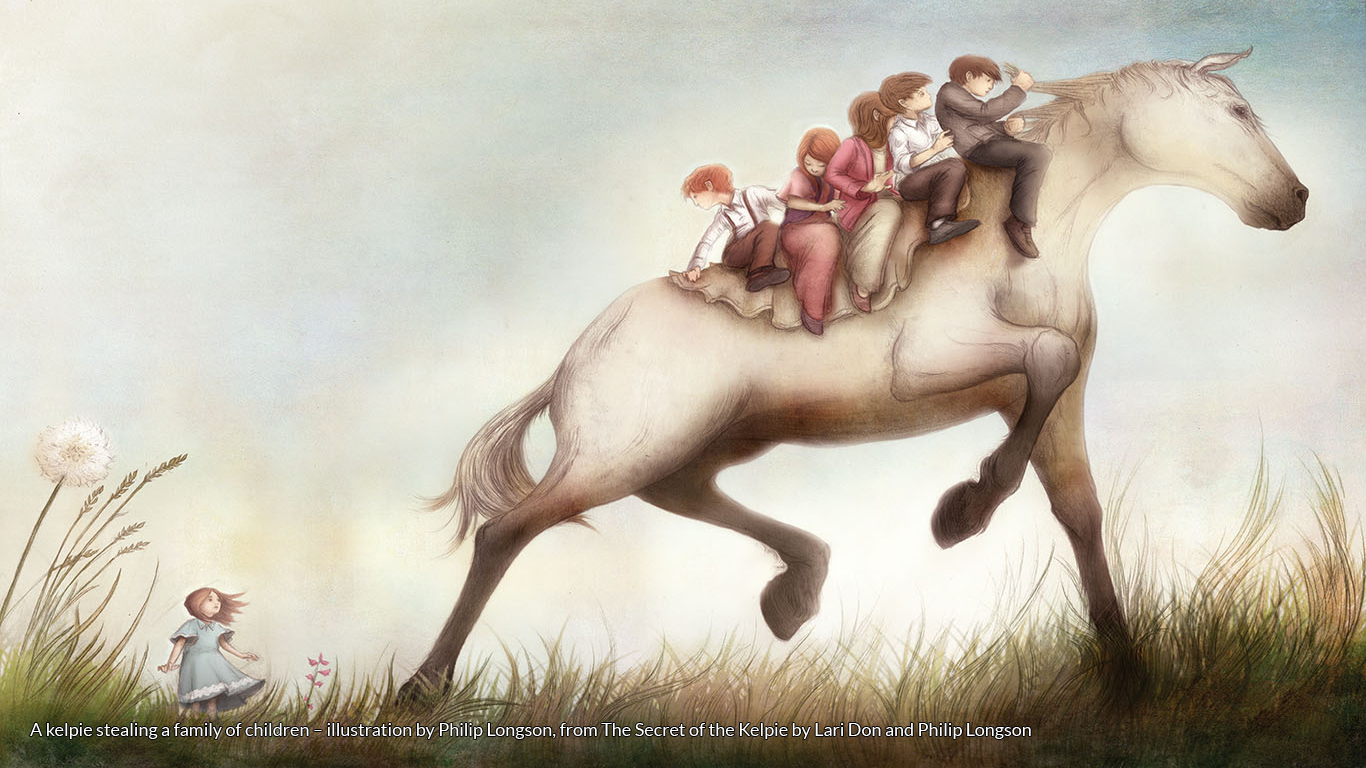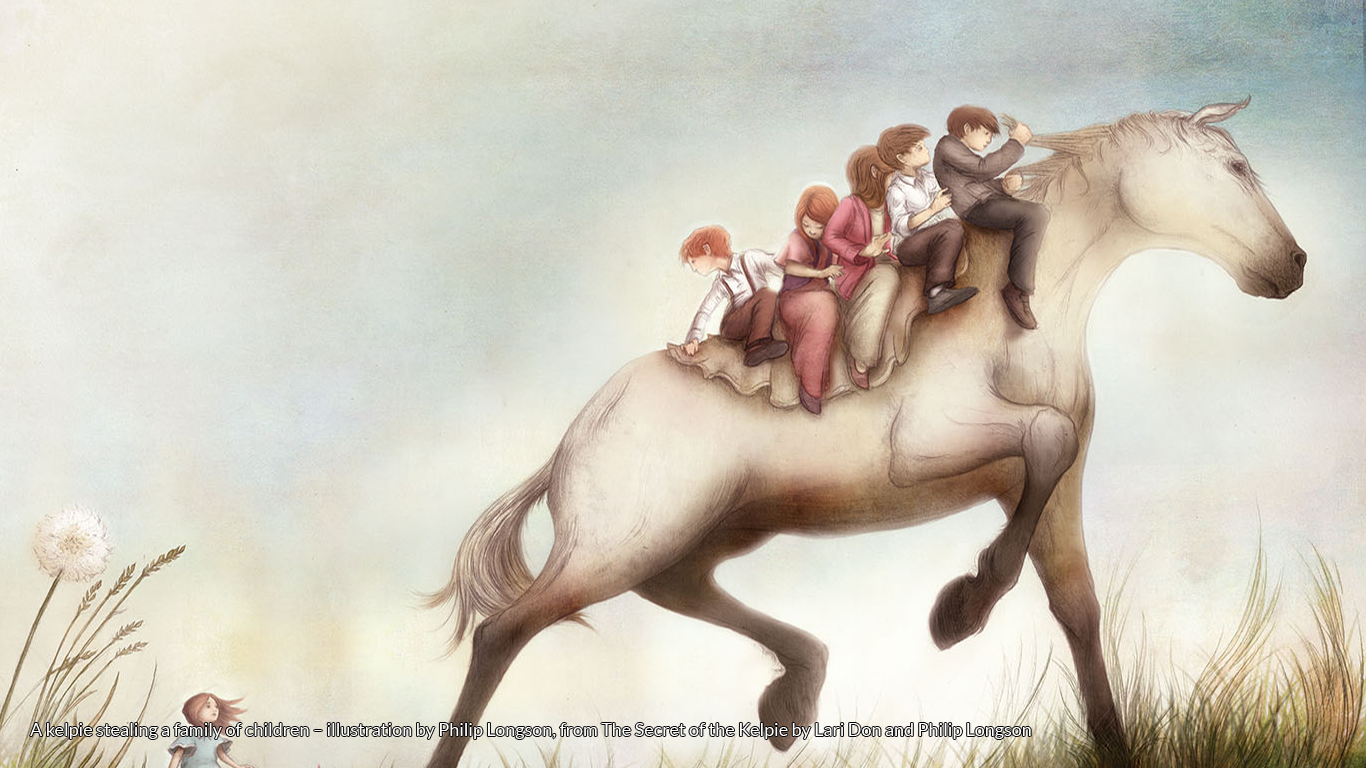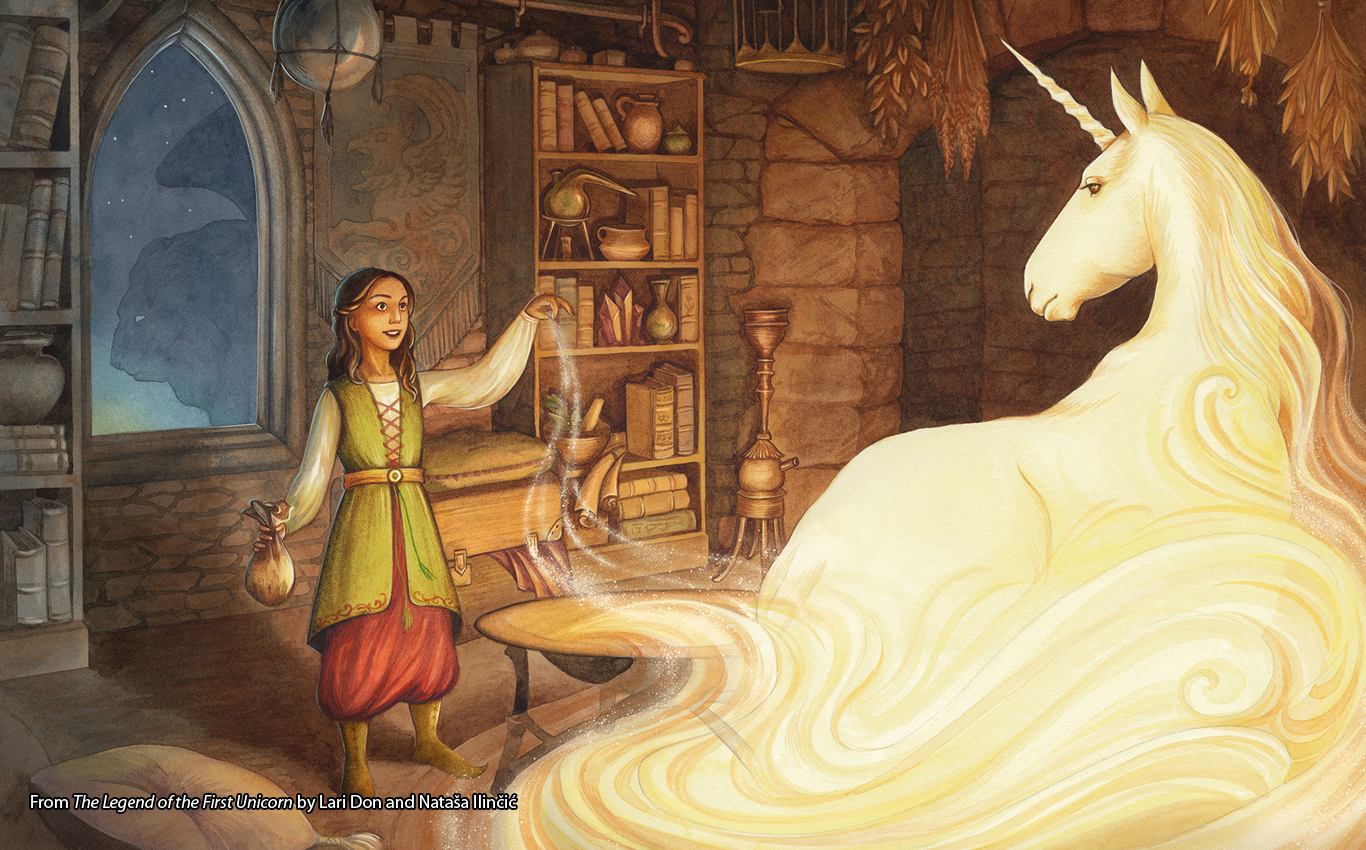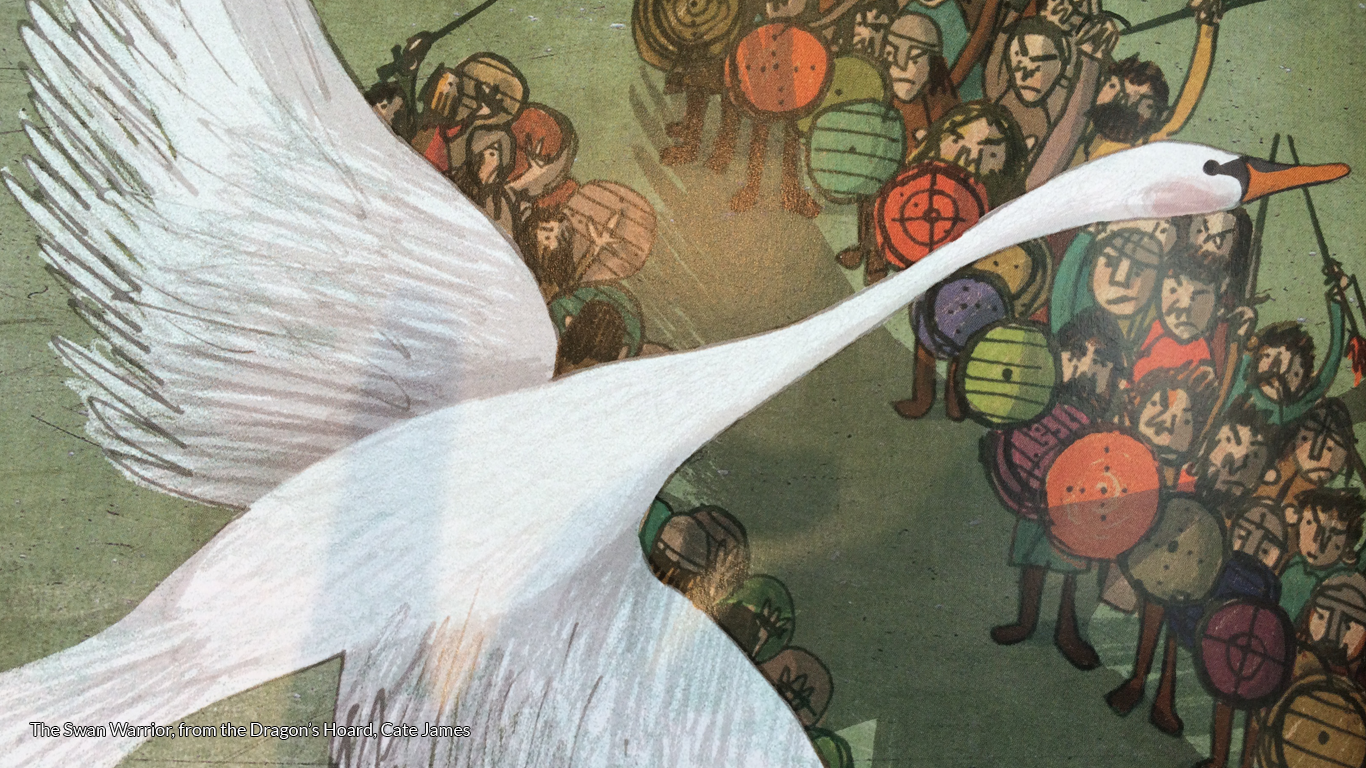
Kelpies are probably one of Scotland’s best-known and most distinctive magical creatures. Kelpies are water-horses, who can shape-shift from underwater monsters to beautiful horses or humans on land, and who lure young women and men under the water to drown them and eat them. It’s a striking image, and a terrifying end. There are kelpie stories from all over Scotland, as I discovered when I researched a new picture book, The Secret of the Kelpie.
I’ve told kelpie stories out loud to audiences for years, and over the last three years I’ve been working with kelpie characters in an adventure trilogy called Spellchasers, but when I was approached by my publishers Floris Books to write a retelling of the kelpie story for younger readers, I wanted to create a strong single narrative from as much kelpie lore as I could find. Rather than relying on the snippets of kelpie magic galloping about my memory, I read the Scottish folklore books on my crowded bookshelves, visited Edinburgh’s wonderful Central Library, and absorbed all the kelpie lore I could.
And I was very surprised by what I found. Kelpies are not just Highland beasts. There are as many kelpie stories from the Doric-speaking east coast of Scotland as there are from the Gaelic-speaking west coast. Even more surprising, there’s not one basic kelpie story with slight local variations. There are lots of distinct and different stories. Kelpies are shapeshifters, so I probably shouldn’t have been surprised at the many and varied shapes their stories take.
There are a few reliable points of similarity. Water and shapeshifting. Horses and hunger. But the variations are fascinating:
There are kelpies who steal children, but also kelpies who steal husbands and wives together, or fishermen, or masons to build their chimneys.
There are kelpies who transform into handsome young men, but also kelpies who become old women.
There are white kelpies, but also black and golden kelpies.
There are kelpies who live in rivers, and kelpies who live in lochs.
There are horse-shaped kelpies with magically adhesive hides: once you climb on or even touch the horse, you’re stuck and can’t get away (unless you slice your own fingers off).
Some human-shaped kelpies were detected (and escaped from) when waterweed was spotted in their hair.
Some kelpies can be driven off or defeated by cold iron.
Kelpies were particularly active on Sundays, targeting people who probably should have been at church.
Kelpies are excellent builders: if you capture them and control them with a magical bridle, they will build mills, bridges, manses and churches.
And the magical attribute that gave me my starting point for the picture book text: some kelpies are keen on devouring groups of children all at once, and the horse’s back can grow longer and longer, to fit all the children on.
Considering so many kelpie stories in such a short time made me think about how and why stories exist, persist and change. When I’m visiting schools, I often ask children why they think we tell stories about monsters.
“Because we all love stories about monsters,” they say.
Then I ask, “Why do you think mums and dads and grannies and neighbours told children about a monster in the water?”
And someone in the back row always says, “So the wee ones were scared to go near the water, and didn’t fall in and drown.”
That is probably why there are stories about monsters in the water (not just Scottish water, but monsters in bodies of water all over the world.)
But why do particular stories persist? Why is the kelpie’s tale still being told, and still being worked with? (By the end of 2017, I will have six books published with kelpie characters of some kind. And I’m not the only writer inspired by kelpies: Maggie Stiefvater, Dick King Smith, Annemarie Allan and Gill Arbuthnott have all written about them.) Is it the image of the horse by the water? Is it the fascination and fear of being desired then devoured by something so beautiful and so dangerous? I don’t claim to know all the answers, but I enjoy considering the questions!

Then there’s the most surprising element of the kelpie trail around Scotland: the wide differences. No one kelpie story (not even mine!) contains all the various attributes of kelpies. I had half-expected, in my research, to find that the same story had been transplanted from one loch to another, with very minor changes, like the colour of the horse. The desire to give a story a local setting (‘and she vanished just over there’) is understandable, but why and how did the plot of stories change so much? The sticky skin? The lengthening back? The building of mills? These magical details must have been devised by individual storytellers.
We owe a huge debt to the storytellers of old who weren’t just passing on stories, but actively crafting them into new shapes to delight their audiences. They gave us such an amazing and creative treasury of kelpie lore, but they also gave us all the other variations of traditional tales all over the world. There is never just one perfect, correct, true version of any tale (something all writers who attempt to capture folklore and trap it in the pages of books should be careful to remember!)
But all this variation meant that once I’d identified the kelpie lore I needed to tell the story of Flora and her big brothers and sisters meeting a beautiful white horse by the loch one Sunday, I didn’t need all the rest. (I was writing a story, not a list!) I had a notebook full of fantastic kelpie information, and nowhere to put it. So my wonderful publishers, Floris, created a map, with lots of locations where kelpie stories have been told, and little snippets of the stories. The map links to kelpie stories in the Isle of Skye, the Western Isles, Loch Lomond, the River Spey, the River Don, and lots of other stunning locations. We hope the map will encourage families to discover their local kelpie tales, and visit their local loch or river, to find their own kelpie magic. But our map isn’t comprehensive, it simply reflects the research I did. I’m a fiction writer, not an academic, and once I’d read enough kelpie lore to spark off the story of The Secret of the Kelpie, I stopped reading and started writing. But there must be more kelpie stories out there …
So if you know stories of kelpies in any other Scottish locations (or even far-travelling kelpies further afield) please let us know and we’ll add your lore to the map.
I hope the kelpie map will help young story-lovers realise that magical stories don’t just come from faraway lands, that there is magic in everyone’s neighbourhood, if you want to go and find it. However, if you go on a kelpie hunt, and you see a beautiful horse with wet hooves, be very, very careful …
Take a look at the wonderful Kelpie Map of Scotland by Floris Books.
Do watch out for Lari’s new picture book, The Secret of the Kelpie, out now (click the image to view on Amazon.) To get £2 off when you order from DiscoverKelpies.co.uk! Simply sign up for the #FolkloreThursday newsletter to receive the discount code to enter at checkout. Newsletter code available until 31 August; offer valid until 30 September 2016.
Recommended Books
References
F Marian McNeill, 1956, The Silver Bough Vol 1, William MacLellan
Otta Swire, 1963, The Highlands And Their Legends, Oliver and Boyd Ltd
Jennifer Westwood and Sophia Kingshill, 2009, The Lore Of Scotland, Random House,
J M McPherson, 1929, Primitive Beliefs In The North East Of Scotland, Longman Green and Co
J F Campbell, 1862, Popular Tales Of The West Highlands, Edmonston and Douglas
Floris Books, 2016, Kelpie Map of Scotland, https://www.google.com/maps/d/viewer?mid=1I0Jks27q9VE94UE40FiNR2G732M&usp=sharing








